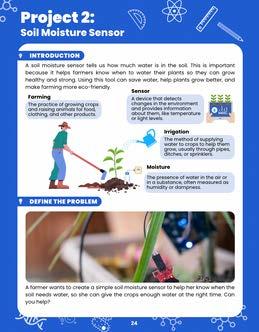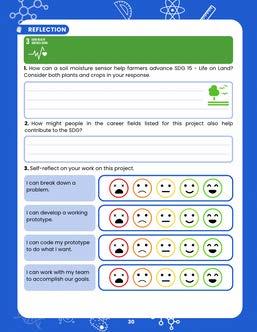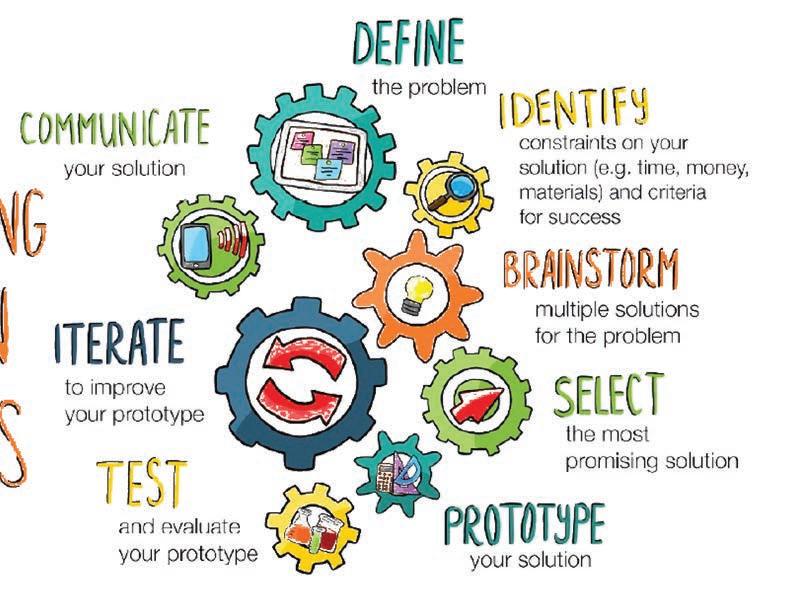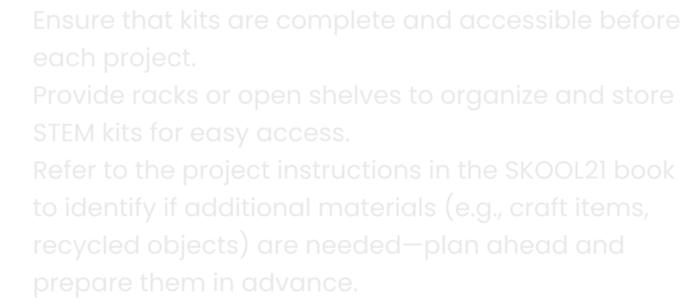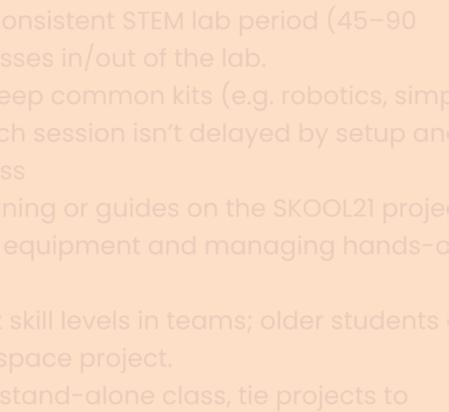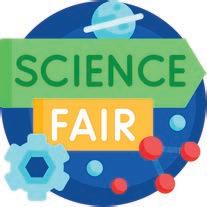TeacherGuide-RaspberryPiPicoLevel11
Teacher Guide
Copyright©2024
Copyright © 20
Author: DanaAlkhatib
Editors: LindseyOwnandErinGoodwin
ISBN: 978-981-17737-5-4
Publishedby:
SKOOL21PTE.LTD.-Singapore
DUOTower,Level8#831
3FraserStreet,189352,Singapore
Allrightsreserved,firstedition2024. Nopartofthisbookmaybereproduced,distributed,ortransmittedinanyformorby anymeans,includingphotocopying,recording,orotherelectronicormechanical methods,withoutthepriorwrittenpermissionofthepublisher,exceptinthecaseof briefquotationsembodiedincriticalreviewsandcertainothernon-commercialuses permittedbycopyrightlaw.
Forpermissionsorinquiries,pleasecontact:
Email: info@skool21.org
Website: https://skool21.org
Preface
WelcometotheFutureofTeachingandLearning!
Welcome to th
Thank you for joi designed not on meaningful, han young innovato science, technol
BuildingonaStrongFoundation
Each level of the
novators series is teachers to lead es, you will guide challenges using creating a strong
Thankyouforjoiningusonthisexcitingjourney!TheSKOOL21STEMInnovatorsseriesis designednotonlytoignitecuriosityinstudentsbutalsotoempowerteacherstolead meaningful,hands-onSTEMlearningexperiences.Throughthisseries,youwillguide younginnovatorsastheyexplore,design,andsolvereal-worldchallengesusing science,technology,engineering,andmathematics(STEM).
EachleveloftheSKOOL21STEMseriesbuildsuponthepreviousone,creatingastrong continuumoflearning—fromsimplemachinestoadvanced3Dmodeling.Students travelthroughkeytechnologicaleras,fromtheIndustrialRevolutiontothe innovationsshapingourfuture.Nomattertheirstartingpoint,everylearnerwill discovernewskillsanddeeperunderstandingalongtheway.
LearningbyDoing
AtSKOOL21,webelievestudentslearnbestbydoing.Eachbookcomeswitha comprehensiveSTEMkit,enablingstudentstobuild,test,andexploreconcepts throughhands-onchallenges.Asateacher,youwillfacilitateengagingprojects wherestudentsactivelycreate,problem-solve,andapplycriticalthinkingskills—all whilehavingfun.
MakingaReal-WorldImpact
Everyprojectisdesignedtoconnectlearningtoreal-worldissues,inspiredbythe SustainableDevelopmentGoals(SDGs).Throughthesechallenges,studentsseehow theirideascancontributetosolvingproblemslikecleanwateraccess,renewable energy,andenvironmentalconservation—empoweringthemtoenvisionabetter world.
TeachingLikeaPro
TheSKOOL21STEMprogramalignswithinternationalstandardsandbestpractices, ensuringthatbothteachersandstudentsaredevelopingthecollaboration, innovation,anddesignthinkingskillsvaluedintoday’sworld.You’renotjust supportingschoolwork—you’repreparingthenextgenerationofthinkers,leaders, andchangemakers.
Building on a not just leaders, and c
IntroductiontotheKit
TheSKOOL21STEMRaspberryPiPicoLearningKitisahands-onelectronicsand codingkitdesignedforLevel11students.PairedwiththeSTEMInnovators Handbook,itintroduceslearnerstoembeddedsystems,physicalcomputing, andreal-worldautomationthroughengaging,project-basedlearning.
1
AttheheartofthekitistheRaspberryPiPico,acompactyetpowerful microcontrollerpoweredbytheRP2040dual-coreArmCortex-M0+processor. Itenablesstudentstobuildresponsivesystemsthatconnectcodewithrealworldhardware.
LessonStructure
Eachlessoninthehandbookfollowsastructuredformattoensureclarityand effectiveimplementation.Asamplesolutionisalsofoundattheendofeach lesson.Thestructureincludes:
Lessonobjectives
NGSSStandards
CambridgeScienceStandards
ISTEStandardsConnections
CambridgeMathStandards
CommonCoreMathStandards
DefinetheProblem
Studentsareintroducedtothescienceconcept andarelatedrealworldproblemtheyaretasked withsolving.
GettingStarted
Everyprojectbeginswithguidedfirststeps.This helpsthestudenttoconfidentlytacklethe challengewithasolidfoundation.
DesignandPlan
Build-Test-Improve
Studentsbrainstormindividually,thencollaborate withtheirteamtocomeupwiththebestdesign plan.
Studentscollaboratetobuild,test,andimprove models.Then,theypracticegivingandreceiving constructivefeedback.
MathandScienceConnection/Reflect
Studentsconnecttheirlearningbacktothe academicobjectivesandanswerguided reflectionquestions.
TheEngineeringDesignProcess ocess
TheEngineeringDesignProcess(EDP)isasystematicapproachusedby engineersanddesignerstosolveproblemsandcreateinnovativesolutions.It providesastructuredframeworkfordevelopingnewproducts,processes,or systemsbyfollowingaseriesofwell-definedsteps.Thisprocessisnotonly applicableinengineering,butisalsowidelyusedinvariousSTEMdisciplinesto tacklechallengesanddevelopcreativesolutions.
Forstudentsinfirstgradeandabove,thetypicalEngineeringDesignProcess followsmultipleiterativesteps,includingidentifyingaproblem,researching, brainstorming,designing,prototyping,testing,andrefiningsolutions.
Thisstructuredapproachencouragescreativity,criticalthinking,anditeration, formingastrongfoundationforfutureSTEMlearning.
forming a str
FosteringSocialSkills
STEMactivitiesnaturallybuildkeysocialskills.Teacherscanhelpstudents practiceandstrengthentheseskillsbyguidingthemduringgroupwork, discussions,andprojectchallenges.
Keysocialskillsdevelopedinclude:
Encouragestudentstoshareideas andassignrolesduringgroup worktobuildteamworkand respectfordifferentperspectives.
Promptstudentstoask"why"and "whatif"questionswhensolving problemsordesigningsolutions.
Collaboration EmpathyandRespect
Remindstudentstovalue everyone'sideasandsupport peersbyusingkind,respectful language.
Coach studentstotalkthrough disagreementscalmlyandfind solutionsthateveryonecan accept.
Buildreflectionintotheprocessby askingstudentswhatworkedwell, whatwaschallenging,andwhat theywoulddodifferentlynexttime.
Communication
Modelclearcommunicationand askstudentstoexplaintheir thinkingandlistencarefullyto teammates.
Problem-Solving
Challengestudentstotrydifferent strategieswhentheyface obstaclesandpraisepersistence.
TimeManagement
Helpteamssetmini-deadlines andguidethemtobreakprojects intosmaller,manageabletasks.
PresentationSkills
Givestudentsregularchancesto presenttheirworktopeers,using clearspeakingandsupportive feedback.
Teamworking
Celebratestrongteamworkby recognizingwhenstudentsshare leadership,encourageeachother, andsolveproblemstogether.
TeachingSTEMalsoteachesstudentshowtothink,work,andlead.Byactively supportingsocialskillsduringprojects,teacherspreparestudentsnotjustfor academicsuccess,butforfuturecareersandlifechallenges.
academic su
MakerspaceSetup
Amakerspaceisacreative,hands-onareawherestudentsexploreSTEM conceptsthroughbuilding,experimenting,andsolvingproblemstogether.This guideisdesignedforteacherswhoarenewtoSTEMandlookingforclearstepsto setupandmanageamakerspace.
SpaceDesign:
Chooseaclean,well-litspacewithroomtomove. Arrangetables/chairsinclustersof2–4students. Uselow,openshelvesforeasyaccesstomaterials. For30students,750–900sqftisrecommended (25–30sqftperstudenttoallowmovement, collaboration,andtool/machine/materialuse).
MaterialsManagement:
Ensurethatkitsarecompleteandaccessiblebefore eachproject.
Provideracksoropenshelvestoorganizeandstore STEMkitsforeasyaccess.
RefertotheprojectinstructionsintheSKOOL21book toidentifyifadditionalmaterials(e.g.,craftitems, recycledobjects)areneeded—planaheadand preparetheminadvance.
SharedResources:
ProvideoneSTEMkitpersmallgroup. Encourageteamworkbyhavingstudentsco-design andco-buildprojects.
SafetyFirst: Keep a fi
Setsimplesafetyrulesandreviewoften. Supervisealltooluseclosely. Keepafirst-aidkitinthespace.
STEMClassroomManagement
STEMclassesarehands-on,highlyengaging,andoftennoisy—that’sagood thing!Butwithoutclearroutinesandstructures,theycanquicklybecome chaotic.Awell-managedmakerspaceallowsstudentstoexploreandinnovate safely,responsibly,andcollaboratively.
STEMClassSessionRoutine
Setaclearandconsistentstructuretoeachsessionsostudentsknowwhatto expectandstayfocused:
90-minuteproject (Grade3toGrade12)
Grade 3 to Grade 12)
5-minute
45-minuteproject (Pre-KtoGrade2)
o ect Pre-K to Grade 2)
SpaceOrganization:
Provideracksoropenshelvestostorekitsneatlyandaccessibly.
ToolandMaterialsRules:
Usetoolswithcare–noplayingormisusingmaterials.
Returneverythingtoitslabeledplace.
Askbeforetakingextrasupplies.
Handstoyourself—respectothers’creationsandspace.
Assignspecificworkzones:BuildArea,SupplyRack,QuietZone,Cleanup Station.
Keepaprojectmaterialchecklisttomakesurekitsarecompletebefore starting.
Onlyonegroupmember(MaterialManager)maycollectmaterialsatatime.
GroupManagementwithTeamRoles
Groupworkcanbemessywithoutstructure.SKOOL21encouragesstudent collaboration,sorotatingroleshelpsbalanceresponsibilityandensure activeparticipation:
Keepsteamontask,trackstime,encourages collaboration.
Collectskits/materialsfromtheteacher,ensuressupplies arereturnedpost-build.
Sharesoutcomes,challenges,andsolutionswiththeclass.
Evaluatesthemodel,givesfeedback,suggestschanges.
ImplementationGuide
TheSKOOL21STEMInnovatorsHandbookoffersproject-basedSTEMlessonsfor Pre-KthroughGrade12.Teacherscanusethreemainmodelstoimplementthese projects:
IntegratedApproach
EmbedSTEMprojectsintoexistingscienceandmathlessons.Forexample,a scienceunitonplantsmightincludeahands-onengineeringchallengefrom thehandbook.ThisalignsSTEMactivitiesdirectlywithcurriculumstandards andlearningobjectives.ResearchshowsthatteachingSTEM subjectstogether (aswithintegratedlessons)deepensunderstandingandretentionandmakes learningmorerelevantandconnectedtotherealworld.
Advantages:
Reinforcesrequiredscience/mathstandardswithhands-onapplication. Buildsproblem-solvingandcritical-thinkingskillsthroughproject-based learning.
Helpsstudentsseeconnectionsacrosssubjects(an“interconnected viewpoint”).
Usesexistingclasstime(noextraperiodsneeded),soSTEMisn’tanadd-on butpartofthecurriculum.
PracticalTips:
Alignprojectstolessons: ChooseSKOOL21projectsthatmatchyourunit goals(e.g.useasimplemachineprojectduringaforces&motionunit).
Startsmall: BeginwithashortSTEMactivity(one45-minutesession)ina scienceormathlesson,thenbuilduptolongerprojects.
Co-teachifpossible: Collaboratewithascienceormathcolleagueto shareplanningandbringindifferentexpertise.
Usegrade-appropriatepacing: ForPre-K–Grade2,integratea45-min STEMmini-projecteachweek;forGrade3+,youmightsplita90-min scienceperiodintolecture+projecttime.
connect
Emphasizestandards: SKOOL21projectsaredesignedtoalignwithNGSS, CommonCorestandards,Cambridgemathandscience.Highlightthese connectionsinyourlessonplantomeetacademicgoals.
Stand-AloneClassApproach
ScheduleadedicatedSTEMclassormakerspacesession(e.g.aweekly90minutelabperiodorrotatingSTEM special).Inthismodel,studentsworkina makerspaceorlabwithtoolsandmachines(likeroboticskits,3Dprinters,craft materials,etc.).Amakerspaceis“acollaborativeworkspaceinsideaschoolfor making,learning,andexploring”.StudentsinteamstackleSKOOL21projects fromstarttofinish,usinghands-onmaterialsratherthanjusttextbooks.
Advantages:
Focusedhands-onlearning:Studentscantakeabstractconceptsand makethemconcrete(forexample,learningcircuitrybyactuallybuildinga papercircuit).
Resilienceandcreativity:Thetrial-and-errornatureofmakingteaches perseverance;studentslearntoiterateondesignswhenthingsdon’twork andthusdevelopgrit.
Equityandaccess:Awell-stockedSTEMlabgivesallstudents(including girlsandunder-representedgroups)equalaccesstotechandengineering tools.
PracticalTips: g
Scheduleregularly: BlockoutaconsistentSTEMlabperiod(45–90 minutes)eachweekorrotateclassesin/outofthelab.
Preparematerialsinadvance: Keepcommonkits(e.g.robotics,simple circuits,designsets)readysoeachsessionisn’tdelayedbysetupand leavetimeforcleanupduringclass
Trainteachers: ProvidebasictrainingorguidesontheSKOOL21projectsso teachersfeelconfidentusingtheequipmentandmanaginghands-on activities.
Groupstudentsthoughtfully: Mixskilllevelsinteams;olderstudentscan mentoryoungeronesinamakerspaceproject.
Blendwithcurriculum: Eveninastand-aloneclass,tieprojectsto standards(e.g.acodingprojectthatteachesmathlogicoradesign challengethatreinforcesphysicalscienceconcepts).
Extra-CurricularApproach
RunSTEMprojectsasafter-schoolclubs,lunch-timeactivities,orsummer camps.Theseareoptionalprograms(STEMclubs,roboticsteams,coding camps,etc.)whereinterestedstudentscanexploreSKOOL21challengesmore freely.After-schoolSTEM“engagesstudentsinhands-on,real-worldprojects,” makingSTEMfeelexcitingandrelevant.
Advantages:
Extratimetoexplore:Studentsgetmorehourstoquestion,tinker,andlearn beyondthelimitedschoolday.Forexample,aweeklyroboticsclubmight meetforanhourafterschool.
Buildsinterestandidentity:Funclubactivitiessparkmotivationanda positiveattitudetowardSTEM,helpingstudentsdevelopaSTEMidentity.
Flexibleandstudent-driven:Studentsself-select;theyworkattheirown paceoncreativeprojects(e.g.codingagame,buildingamodelbridge).
Reachesdiverselearners:Clubscantargetdifferentagegroupsandskill levels–frombasicscienceforyoungerkidstoadvancedroboticsforteens. Thishelpsbridgeenrichmentgaps(makingSTEMopportunitiesavailableto allstudents).
PracticalTips:
Keepitlow-stakes: Emphasizefunandcuriosityovergrades.Short,handsonprojects(likemini-challenges)keepstudentsengaged.
Advertisewidely: Inviteallstudents,notjusthigh-achievers.Useschool announcements,flyers,andparentnewsletterstoraiseawareness.
Tietocompetitionsorshowcases: Useevents(sciencefairs,robotics tournaments)tomotivatetheextraeffort.
Leveragesummerorcamptime: Ifresourcesallow,runaweek-longSTEM summercampusingseveralSKOOL21projectsfordeeperimmersion.
Collaboratewithcommunity: Inviteguestspeakers(engineers,makers)or partnerwithlocallibraries/museumsformaterialsandinspiration.
HybridApproach (BlendingAllModels)
Inpractice, manyschoolsuseamixofmodels.Ahybridapproachmight integratesimpleSTEMtasksintoregularlessonsandalsoofferadedicated STEMlabplusanafter-schoolclub.Thisway,everystudentgetssomeSTEM exposureandthosewholoveitcandivedeeper.
Whentointegrate:
Usecurriculum-linkedprojectsduringcoreclasses.Forexample,inaGrade4mathclassyou mightuseaSKOOL21projectongearstoteachratios,orinscienceclassstudentsmight buildamodelecosystem.Smallerorsingle-sessionactivitiesfitwellhere.
Reservelonger,open-endedprojectsforSTEMclassorthemakerspace.Complex engineeringchallenges(robotdesign,3Dmodeling,advancedcoding)needlongerblocks, sothesesuita90-minSTEMperiodorseriesoflabsessions.
Offerstudentsaspaceforexplorationthatdoesn’tfitthecurriculumortimeline.These projectscanbedrivenbystudentinterestandcanspanseveralweekswithoutpressureto “coverthecurriculum.”
Usingahybridplanensuresflexibility.Teacherscanadapt:ifasemesteris heavywithtesting,leanonafter-schoolclubsforenrichment;whencovering standards,weaveSTEMintolessons.Alwayscheckthatevenfree-formprojects stilltouchacademicgoals.
(Note:SKOOL21projectsarealreadyalignedtoNGSSandCommonCore standards,CambridgeMathematicsandCambridgeScience,sowhether integratedorstand-alone,theysupportlearningobjectives.)
LessonPlans andAnswerkey
Project1:BotanicalSensor
LessonPlan
LearningObjectives
Attheendofthelesson,thelearnerswill:
Duration: 90minutes
Buildaworkingtemperatureandhumiditysensorsetup. WriteandrunPythoncodetodisplaytemperatureandhumidityvaluesonanLCD. ApplymathematicalformulastoconvertCelsiustoFahrenheitandviceversa. Reflectonhowenvironmentalmonitoringcontributestosustainableagriculture.
Materials
Vocabulary
Avasculartissuethattransportswaterthroughoutaplant.
Plantpores.
Tolosewatervaporthroughthestomata.
Anelectricalcomponentthatmeasuresandreportsavalue.
Preparation(TeacherTo-DoBeforeClass)
Logintoalllaptops.OpenthePythonIDEyouuseforRaspberryPiPico(Thonny)andsignin toeachlaptoponadifferentgroupaccount.LeavetheIDEopentoablankscript. FlashandtestonePicopergroup:install/verifyMicroPython,confirmtheUSBserialport appears,andrunasimple“blink”scripttocheckconnections.
Preparetheclassmaterials
Preloadstarterfiles/librariesoneachlaptopandcreateaprojectfolderforsavingcode. SetupandtestonesampleworkingRaspberryPiPicodemo(Pico+sensor/LED)for projectiontotheclass.
Checktheprojector/speakers,ensurealllaptopshaveinternet(fordocs)andlocalcopies ofdatasheets,andverifyyoucantransferfilestoPicosoneachmachine.
LearningActivities(Session1)
Introduction
1.ReadtheIntroductionaloudorassignastudenttoreadit.
2.Askstudentstosharetheirpriorknowledgeaboutplantgrowthandenvironmental monitoring.
3.Discusswhytemperatureandhumidityareimportantingreenhouses.
DefinetheProblem
1.ReadtheProblemStatement:"Zarawantstodevelopatemperatureandhumiditymeterto ensurehergreenhousemaintainstheoptimalconditionsneededforidealplantgrowth."
2.Askstudents:
a.Whatistheproblem?(Maintainingoptimalplantconditions)
b.Whoistheclient?(Zara,agreenhousegrower)
c.Definetheprojectgoals:
d.Buildaworkingsensorsetup.
e.DisplaytemperatureandhumidityontheLCD.
DesignandPlan
1.HavestudentsbrainstormhowtointegratetheLCDintotheirdesignforbettervisualisation.
2.Askstudentstosketchtheirdesignandlabelconnections,ensuringclarityforthebuild phase.
GettingStarted
Wire
1.GuidestudentstocorrectlyinserttheRaspberryPiPicointothebreadboardandlocatethe GND,3V3,andGP16pins.
2.DirectstudentstoconnecttheDHT11sensortotheappropriatepinsontheRaspberryPi Pico:Signal(S)toGP16,Voltage(V)to3V3,andGround(G)toGND.
Code
1.InstructstudentstoopenThonnyIDE,navigateto Project_1a_Temperature_and_Humidity_Print.py,anduploadittothePico.
2.Askstudentstorunthecodeandobservethetemperatureandhumidityreadingsprinted intheconsole.Providetroubleshootingsupportasneeded.
Share
1.Allowgroupstosharetheirprogresswithanothergroup,andlookforsimilaritiesand differencesinhowtheyarecreatingsofar,recognizingthattheyarenotyetfinished.
EndofSession1
LearningActivities(Session2)
1.Promptstudentstomodifythetime.sleep()valuetoprintthereadingsatdifferentintervals (e.g.,everysecond,everyhour).
2.Discusshowsensorreadingsatspecificintervalshelpmonitorgreenhouseconditions effectively. Challenge
Build&Test
1.GuidestudentstowiretheLCDtotheRaspberryPiPico,connectingSCL,SDA,V,andGpins appropriately.
2.Instructstudentstouploadlcd128_32.pyandlcd128_32_fonts.py,thenrun Project_1b_Temperature_and_Humidity_Meter.pytodisplayreadingsontheLCD.
3.Directstudentstotesttheirsetupbycheckingifthecorrectvaluesaredisplayedonthe LCD.
4.Encouragestudentstoevaluatewhetherthecurrentgreenhouseconditionsaresuitablefor plantgrowthandsuggestadjustmentsifnecessary.
Share&Improve
1.Pairgroupsandhavethemsharetheirprojects,discussingdesignchallengesand solutions.
2.Askstudentstoimprovetheirdesignsbasedonfeedbackorcreateanalternativedesign toachievethesamefunctionality.
1.AssignstudentstoconverttemperaturevaluesbetweenCelsiusandFahrenheitusingthe formulaF=(C×1.8)+32
2.ChallengestudentstographtherelationshipbetweenCelsiusandFahrenheitvalues, highlightingthelinearcorrelation.
1.DiscusshowenvironmentalmonitoringsupportsSustainableDevelopmentGoal15:Lifeon Land.
2.Encouragestudentstowritehowtheirsensorprojectcouldhelpreduceenvironmental impactinagriculture.
IfZarawantsreadingseveryhour,time.sleep()shouldbesetto3600seconds.
Ifhumidityisbelow80%,Zaracanincreasehumiditybywateringplantsor addingahumidifiertothegreenhouse.
TouseGP17insteadofGP16,updatethecodelinedht_pin=machine.Pin(16)to dht_pin=machine.Pin(17).
Conversionexamples:
Project2:PredatorDetector
LessonPlan
LearningObjectives
Attheendofthelesson,thelearnerswill:
Duration: 90minutes
BuildapredatordetectorusingaPIRmotionsensorandRGBLED. WritePythoncodetocontroltheRGBLEDbasedonPIRsensorreadings. Analyzepredator-preyrelationshipstounderstandsurvivaltraits. Solvemathematicalproblemsrelatedtopredatordetectionfrequencies.
Materials
Vocabulary
Word Meaning
Naturalselection
PIR
Input
Output
Survivalofthefittest.
PassiveInfraredSensorwhichdetectsmotion.
Acomponentthatprovidesinformation,e.g.,asensor.
Acomponentthatindicatestheresultoftheinput,e.g.,anLED.
Preparation(TeacherTo-DoBeforeClass)
Logintoalllaptops.OpenthePythonIDEyouuseforRaspberryPiPico(Thonny)andsignin toeachlaptoponadifferentgroupaccount.LeavetheIDEopentoablankscript. FlashandtestonePicopergroup:install/verifyMicroPython,confirmtheUSBserialport appears,andrunasimple“blink”scripttocheckconnections.
Preparetheclassmaterials
Preloadstarterfiles/librariesoneachlaptopandcreateaprojectfolderforsavingcode. SetupandtestonesampleworkingRaspberryPiPicodemo(Pico+sensor/LED)for projectiontotheclass.
Checktheprojector/speakers,ensurealllaptopshaveinternet(fordocs)andlocalcopies ofdatasheets,andverifyyoucantransferfilestoPicosoneachmachine.
LearningActivities(Session1)
Introduction
1.Readtheintroductionaloudoraskastudenttoreadit.
2.Discusshowpredatorsandpreyadaptforsurvivalusingexamplesofpredator-prey dynamics.
3.Highlighttheroleoftechnologyinstudyinganimalbehaviorandbiodiversity conservation.
DefinetheProblem
1.Readtheproblemstatement:"ArshadandMalikwanttocreateapredatordetectorto testifcertainspecieswillsurvivebetterinthewild."
2.Askthestudents:
a.Whatistheproblem?(Testingspecies'abilitytoavoidpredators)
b.Whoistheclient?(ArshadandMalik,researchersstudyingwildlife)
3.Definetheprojectgoals:
a.DetectmotionusingaPIRsensor.
b.ChangeRGBLEDcolourbasedonPIRsensorinputs.
DesignandPlan
1.Encouragestudentstobrainstormideasforenhancingthedetector,suchasintegrating soundoutputfordetection.
2.Havethemsketchtheirdesign,labellingconnectionsforclarity.
GettingStarted
1.GuidestudentstoplacetheRaspberryPiPicofacedownintotheprototypeshield.
2.InstructthemtoconnectthePIRmotionsensorwirestotheappropriatepins:
a.Signal(S)toGP2
b.Voltage(V)to3V3
c.Ground(G)toGND
1.DirectstudentstoopenthefileProject_2a_Predator_Detector.pyinThonny.
2.AskthemtorunthecodeandtestthePIRsensorbywavingtheirhandtotrigger motiondetection.
Share
1.Allowgroupstosharetheirprogresswithanothergroup,andlookforsimilaritiesand differencesinhowtheyarecreatingsofar,recognizingthatthey arenotyetfinished.
EndofSession1
LearningActivities(Session2)
Challenge
1.PromptstudentstomodifythecodetomaketheRGBLED blinkfasterwhendetecting motion.
2.Askthemtoexplainhowmodifyingcodecanhelpbettersimulatepredator-prey scenarios.
Build&Test
1.1.GuidestudentstoconnecttheRGBLEDtothePicoPrototypeShield: a.LonglegtoGNDpin b.OtherlegstoGP3,GP4,andGP5forred,green,andbluecolors.
2.InstructthemtouploadProject_2b_Predator_Detector_RGB_LED.pyandtesttheRGBLED behaviorwithPIRsensorinputs.
1.Directstudentstotesttheirdetectorbysimulatingpredatormotion.
2.EvaluateiftheRGBLEDchangescolorsaccuratelybasedonthePIRsensor'sreadings.
3.Pairgroupsandhavethemsharetheirdesignsandtestresults.
4.Askstudentstoimprovetheirdesignbasedonpeerfeedbackorcreateanalternative mechanismformotiondetection.
1.Assignstudentstosolvetheevaluationproblemsrelatedtopredatordetection frequenciesandexponentialfunctions.
2.Discusshowmathematicshelpsmodelreal-worldscenariosinwildlifeconservation.
1.Discusstheroleofpredatordetectorsinbiodiversityconservationandachieving SustainableDevelopmentGoal15:LifeonLand.
2.Encouragestudentstowriteashortreflectiononhowtechnologycanmitigatehumanwildlifeconflicts.
Housecatstriggerthealarmata×0.25a\times0.25.
Ifhousecatstriggerthealarm10times,coyoteswouldtriggerit10×3=3010 \times3=30times.
Coyotespossesstraitssuchasenhancedspeed,agility,andheightenedsenses, whichareevolutionaryadvantagesforsurvival.
Exponentialfunction:
n(t)=5*2^(0.5*t)
At4hourspastmidnight:n(4)=5*2^2=20
At8hourspastmidnight:n(8)=5*2^4=80
40triggers:
Solve5*2^(0.5*t)=40 t=6hourspastmidnight.
Project3:NutritionTracker
LessonPlan
LearningObjectives
Attheendofthelesson,thelearnerswill:
Duration: 90minutes
BuildanutritiontrackingsystemusingakeypadandLCDdisplay. WriteandrunPythoncodetocalculateanddisplaynutritionalvalues. Applymathematicalconceptstosolvereal-lifenutritionalproblems. Reflectontheroleofnutritioninmaintainingoverallhealthandwell-being.
Materials
Vocabulary
Aunitforfoodenergyequivalenttotheheatneededtoraisethe temperatureof1gofwaterby1°C.
Moleculesofaminoacidswhichthebodyusestobuildandrepair musclesandbones.
Moleculesoffattyacidswhichprovideenergywhenburnedandare storedinfatcellsinthebodytobeusedwhenneeded.
Preparation(TeacherTo-DoBeforeClass)
Logintoalllaptops.OpenthePythonIDEyouuseforRaspberryPiPico(Thonny)andsignin toeachlaptoponadifferentgroupaccount.LeavetheIDEopentoablankscript. FlashandtestonePicopergroup:install/verifyMicroPython,confirmtheUSBserialport appears,andrunasimple“blink”scripttocheckconnections. Preparetheclassmaterials
Preloadstarterfiles/librariesoneachlaptopandcreateaprojectfolderforsavingcode. SetupandtestonesampleworkingRaspberryPiPicodemo(Pico+sensor/LED)for projectiontotheclass.
Checktheprojector/speakers,ensurealllaptopshaveinternet(fordocs)andlocalcopies ofdatasheets,andverifyyoucantransferfilestoPicosoneachmachine.
LearningActivities(Session1)
Introduction
1.ReadtheIntroductionaloudorassignastudenttoreadit.
2.Askstudents:
a.Whyistrackingfoodintakeimportant?
b.Howdoesunderstandingnutritionhelpusmakehealthierchoices?
3.Discussreal-lifeapplicationsofnutritiontrackingsystems,suchasfitnessappsordiet plans.
1.ReadtheProblemStatement:"FazalandDaliawanttoensuretheyareeatingadequate amountsofprotein,carbohydrates,andhealthyfatseachday.Canyouhelpthemcreate anutritiontrackingsystem?"
2.Askthestudents:
a.Whatistheproblem?(Trackingdailynutritionalintakeaccurately.)
b.Whoistheclient?(FazalandDalia.)
3.Definetheprojectgoals:
a.Buildasystemtotracknutrientintake.
b.DisplaythenutritionalbreakdownonanLCD.
DesignandPlan
1.Havestudentssketchtheirdesigns,ensuringallcomponentsarelabeledand connectionsareclear.
2.Discusswaystomakethesystemuser-friendlyfordifferenttypesofusers.
GettingStarted
Wire
1.GuidestudentstoconnectthekeypadpinstothefollowingRaspberryPiPicoports usingM-FDupontwires:26,22,10,11,19,18,17,16.
2.EnsuretheLCDisconnectedasfollows:
a.SCL->GP21
b.SDA->GP20
c.V->VBUS,G->GND.
Code
1.InstructstudentstoopenThonnyIDEandupload Project_3a_Nutrition_Tracker_Keypad.pytotheRaspberryPiPico.
2.Runthecodetoensurethekeypadvaluesarecorrectlyprintedintheshell.
3.GuidestudentstouploadProject_3b_Nutrition_Tracker_Display.pyandverifythat nutritionaldataappearsontheLCDdisplay.
Share
1.Allowgroupstosharetheirprogresswithanothergroup,andlookforsimilaritiesand differencesinhowtheyarecreatingsofar,recognizingthattheyarenotyetfinished.
EndofSession1
LearningActivities(Session2)
1.Askstudentstomodifythecodetotrackcarbohydratesinsteadofproteins.
2.Encouragethemtodiscusshowtrackingspecificnutrientscansupportdifferentdietary goals(e.g.,low-carbdiets).
1.Guidestudentstocompletethewiringandcodingprocess.
2.Testthesystemtoensureitcalculatesanddisplaysnutritionalvaluesaccurately.
3.Directstudentstoinputdifferentmealdataandverifythesystem’scalculations.
4.Encouragethemtoevaluatethesystem’seffectivenessandsuggestimprovements.
5.Pairgroupstosharetheirdesignsanddiscusschallengesfaced.
6.Proposealternativedesignsorfeaturestoenhancethesystem’sfunctionality.
1. Assignstudentstocalculatethepermutationsofpossiblemealcombinationsusingthe providedoptionsforbreakfast,lunch,anddinner.
2.Discusshowthesemathematicalconceptsapplytocreatingdiversemealplans.
1.Discusstheimpactofnutritiontrackingsystemsonoverallhealthandwell-being.
2.Encouragestudentstowriteabouthowsuchsystemscanpromotehealthier communitiesandsupportSustainableDevelopmentGoal3:GoodHealthandWell-being.
Tomodifythecodetotrackcarbohydrates,changethedisplaytextin Project_3b_Nutrition_Tracker_Display.py.
Ifastudentconsumes60gofproteinperdayandtheirrecommendedintakeis 100g,theLCDshoulddisplay:"Stillneed:40g."
Thepermutationsforthreemealswithtwooptionseachare.
Anutritionistdesignedmealplanswithfouroptionseachforbreakfast,lunch, anddinner:
Calculatethetotalpermutations:.
Iftheorderofmealscanvary,calculatethecombinationsforthreemeals
Project4:AdaptiveBrightness
LessonPlan
LearningObjectives
Attheendofthelesson,thelearnerswill:
Duration: 90minutes
Buildaworkingadaptivebrightnesssystemusingalightsensor. WriteandrunPythoncodetoadjustbrightnesslevelsbasedonambientlight. Modeltherelationshipbetweenlightintensityandphotosynthesisusingmathematical principles.
Reflectontheimportanceofadaptivebrightnesstechnologyinenergyconservation.
Materials
Vocabulary
Word
Photosynthesis
Chloroplast
Photons
Sensor
Meaning
Theprocessbywhichplantsconvertlightenergyintochemicalenergy. Thepartoftheplantcellwherephotosynthesisoccurs.
Particlesoflightthatcarryenergy.
Adevicethatdetectsormeasuresaphysicalpropertyandrecordsor respondstoit.
Preparation(TeacherTo-DoBeforeClass)
Logintoalllaptops.OpenthePythonIDEyouuseforRaspberryPiPico(Thonny)andsignin toeachlaptoponadifferentgroupaccount.LeavetheIDEopentoablankscript. FlashandtestonePicopergroup:install/verifyMicroPython,confirmtheUSBserialport appears,andrunasimple“blink”scripttocheckconnections. Preparetheclassmaterials
Preloadstarterfiles/librariesoneachlaptopandcreateaprojectfolderforsavingcode. SetupandtestonesampleworkingRaspberryPiPicodemo(Pico+sensor/LED)for projectiontotheclass.
Checktheprojector/speakers,ensurealllaptopshaveinternet(fordocs)andlocalcopies ofdatasheets,andverifyyoucantransferfilestoPicosoneachmachine.
LearningActivities(Session1)
Introduction
1.Discusstheconceptofadaptivebrightnessanditsapplicationsindailylife.
2.Explainthesciencebehindphotosynthesisanditsconnectiontoenergyconversionin technology.
RaspberryPi PicoKit Computer
Projector
Cardboard STEMbook
GlueGun
ArtSupplies Tape
1.Introducethetask:“Developanadaptivebrightnesssystemusingaphotoresistorsensor thatadjustsbrightnesslevelsbasedonambientlight.”
2.Defineprojectgoalsandexpectedoutcomes.
DesignandPlan
1.Allowstudentstobrainstormpotentialimprovementstotheiradaptivebrightness system,suchasaddingauserinterfaceormakingthesystemmoreefficient.
1.GuidestudentstoconnecttheRaspberryPiPicotothephotoresistorandLEDona breadboard.
2.Ensureproperplacementofresistorsandwirestocompletethecircuit.
1.InstructstudentstoopenThonnyIDEandupload Project_3a_Nutrition_Tracker_Keypad.pytotheRaspberryPiPico. Wire
1.Allowgroupstosharetheirprogresswithanothergroup,andlookforsimilaritiesand differencesinhowtheyarecreatingsofar,recognizingthattheyarenotyetfinished.
EndofSession1
LearningActivities(Session2)
Challenge
1.Askstudentstomodifythecodetochangethebrightnessdynamicallybasedonvarious ambientlightingscenarios.
1.Guidestudentstoimplementtheirimproveddesignsandtesttheupdatedsystem.
2.Testthesystemunderdifferentlightingconditions.
3.Evaluatethesystem’sresponsivenessandefficiency.
1.Shareprojectoutcomeswithpeers.
2.Discusschallengesandproposepotentialimprovements.
1.ExploretherelationshipbetweenlightintensityandLEDbrightnessthrough mathematicalmodelling.
2.Usetrigonometrytosimulatelightbehaviourthroughouttheday.
1.Reflectontheimpactofadaptivebrightnesstechnologyonenergyconservationandits potentialapplicationsinreal-worldscenarios.
Explainthephysicsbehindphotoresistorfunctionalityanditsuseincontrolling LEDbrightness.
Usemathematicalequationstomodeltherelationshipbetweenlightintensity andresistance.
Discussthesocietalbenefitsofadaptivebrightnesstechnology.
Applytheconceptofcomplexnumberstoanalyzetheelectricalcircuit.
CalculatetheimpedanceandLEDintensityusinggivenmathematicalformulas.
Project5:EnvironmentALAlarm LessonPlan
LearningObjectives
Attheendofthelesson,thelearnerswill:
Duration: 90minutes
Buildaworkingenvironmentalalarmsystemusingathermistorsensor. WriteandexecutePythoncodetomonitortemperatureandactivateanalarmatcritical thresholds.
Modeltherelationshipbetweentemperatureandresistanceusingmathematical equations.
Reflectontheroleoftechnologyinaddressingclimate-relatedchallenges.
Materials
Vocabulary
Extinction
Thermistor
Passivebuzzer
Activebuzzer
Thedeathofaspecies.
Aresistorwhoseresistancechangeswithchangesintemperature.
Abuzzerthatcanproduceamultitudeoffrequenciesbasedonthe input.
Abuzzerthatwaitsforatriggertoproduceasingletone.
Preparation(TeacherTo-DoBeforeClass)
Logintoalllaptops.OpenthePythonIDEyouuseforRaspberryPiPico(Thonny)andsignin toeachlaptoponadifferentgroupaccount.LeavetheIDEopentoablankscript. FlashandtestonePicopergroup:install/verifyMicroPython,confirmtheUSBserialport appears,andrunasimple“blink”scripttocheckconnections. Preparetheclassmaterials
Preloadstarterfiles/librariesoneachlaptopandcreateaprojectfolderforsavingcode. SetupandtestonesampleworkingRaspberryPiPicodemo(Pico+sensor/LED)for projectiontotheclass.
Checktheprojector/speakers,ensurealllaptopshaveinternet(fordocs)andlocalcopies ofdatasheets,andverifyyoucantransferfilestoPicosoneachmachine.
LearningActivities(Session1)
Introduction
1.ReadtheIntroductionaloudorassignastudenttoreadit.
1.Askstudents:
a.Whyistemperaturemonitoringimportantinecosystems?
b.Canyouthinkofexampleswherealarmsareusedtomonitorenvironmental changes?
2.Discusshowtechnologylikethermistorscanhelpdetectcriticalenvironmental conditions.
DefinetheProblem
1.ReadtheProblemStatement:"Createanenvironmentaltemperaturealarmthatwillbuzz whenthebiomeisclosetocriticaldanger."
2.Askstudents:
a.Whatistheproblem?(Monitoringtemperaturetodetectcriticalchanges.)
b.Whoistheclient?(Environmentalscientistsandconservationists.)
DesignandPlan
1.Definetheprojectgoals:
a.Buildasystemthatdetectstemperaturechanges.
b.Activateanalarmwhencriticalthresholdsarereached.
GettingStarted
1.GuidestudentstoplacetheRaspberryPiPicoonthebreadboard. 2.Connectthethermistor,passivebuzzer,and10kΩresistorasspecified.
3.Ensureallconnectionsmatchtheprovideddiagram.
1.InstructstudentstoopenThonnyIDEandnavigateto Project_5_Temperature_Alarm.py.
2.Guidestudentstouploadthecodeandobservetemperaturereadingsintheshell. Wire Code
Share
1.Allowgroupstosharetheirprogresswithanothergroup,andlookforsimilaritiesand differencesinhowtheyarecreatingsofar,recognizingthattheyarenotyetfinished.
EndofSession1
MathandScienceConnection(canbeassignedhomeworkaswell)
Reducingthesleep()valueincreasesthefrequencyofthepassivebuzzertone becausetheactivationcycleoccursmorerapidly.
Biscalculatedusingthegivenresistancesandtemperatures:K. At400K,theresistanceisapproximatelyΩ.
Usethemodulusfunctiontodeterminecriticalpointsandtrendsbasedon environmentaldata.
Suchalarmscouldalertcommunitiestocriticaltemperaturethresholds, enablingpreventivemeasurestomitigateclimaterisksandprotectbiodiversity.
AssessmentGuide
AtSKOOL21,assessmentsareatoolforlearningandgrowth—notjustgrading. FromPre-KtoGrade12,weuseassessmentstoguidestudentsinbuildingskills, confidence,andaloveofSTEMlearning.Wefocusonfeedback,reflection,and continuousimprovementtohelpeverystudentreachtheirfullpotential.
Getasnapshotof students’starting knowledgebefore onboardinginSTEM.
StudentsembarkontheSTEMLearningJourney,consisting ofanIntroductoryLessonfollowedby15hands-onSTEM projectsalignedwithcurriculumobjectives.
Helpstudentsconnectmath andscienceconceptsthrough real-worldSTEMchallenges.
Pre-Assessment(optional)
Encouragestudentstoreflect, takeownershipoftheirlearning, andsetpersonalgoals.
Celebratestudents' learningthroughrealworldprojectsthatapply keyskills.
Pre-assessmentcanbeformal(ashortquiz)orinformal(adiscussionoractivity)–SKOOL21 treatsitasoptionalsoteachersuseitwhenitaddsvalue.Donethoughtfully,pre-assessment honorsDewey’sideathatconnectingtostudents’priorexperienceboostslearning
TeacherTips:
Keepitlow-stakes:Thumbs-up/downpolls. Open-endedquestions:Quickdiscussions. Mini-quizzes:Shortandsimple.
KWLCharts:Capturewhatstudentsknowandwanttolearn. Play-basedobservation:EspeciallyforPre-K/K
Math&ScienceConnection
Byassessinghowstudentsapplymathskillsinscienceactivities(andviceversa),teachers candeepenunderstandingofbothsubjects.Thisunderscoresthereal-worldrelevanceof STEMlearningandreinforcescriticalthinking.
Cross-linkactivities:Measure,graph,orcalculate duringscienceexperiments.
TeacherTips: just grading tools
Userealtools:Rulers,scales,charts,simplecoding tools.
Askmathquestionsinscience:“Howtallisyourplant?” Teamwork:Solvescienceproblemswithmathin groups.
Linktostandards:Alignwithbothmathandscience
Link to sta goals.
Self-AssessmentRubrics
TeacherTips:
Introducerubricsearly:Define"what successlookslike."
Modelreflection:Scoresamplework together.
Selfandpeerreview:Studentsrate anddiscuss.
Askreflectivequestions:“Whatwas yourbiggestchallenge?”
Celebratehonesty:Praiseaccurate self-assessment.
Post-Assessment:CapstoneProject
Self-reflectonyourworkonthisproject.
Icanbreakdown aproblem.
Icandevelopa workingprototype.
Icancodemyprototype todowhatIwant.
Self-assessmenthelpslearnersidentifytheirstrengthsandareastoimprove,reinforcing metacognition.Teachersplayaguidingroleinthisprocess,helpingstudentslearnhowto honestlyandconstructivelyjudgetheirwork.
Thecapstoneprojectdesignedasaculminatingexperienceforstudentstodemonstrate andsharetheirlearningwithanauthenticaudience.Thecapstonecanbeconsideredand usedasanassessmenttask,allowingstudentstosynthesizeknowledgeandskillsdeveloped overthecourseofthe15-projectSTEMseries.
Throughthecapstoneproject,studentsengageinameaningfulapplicationofproblemsolving,criticalthinking,andengineeringdesignprinciples.Theyarechallengedtoaddress real-worldproblems,showcasingtheirabilitytointegrateconceptsacrossscience, technology,engineering,andmathematicsdisciplines.
STEMInnovationFair
Tocelebratestudentachievements,schoolsareencouragedtoorganize eventssuchasaSTEMShowcase,InnovationFair,orOpenHouse.These eventsprovideanauthenticplatformforstudentstopresenttheir capstoneprojectstopeers,educators,families,andcommunitymembers. Studentsarticulatetheirdesignprocess,explaintheirdecisions,and respondtofeedbackfromanengagedandsupportiveaudience.
Possiblepresentationformatsinclude:
Interactivedemonstrations
Postersessions
Digitalportfolios
PitchpresentationsmodeledafterprofessionalSTEMconferences
nforcing rn how to celebrating education w
Organizersmayalsoinviteindustryexperts,localbusinesses,oruniversitypartnerstoserve aspanelistsormentors,furtherenhancingthereal-worldrelevanceofstudentprojects.By celebratingstudentinnovationinapublicforum,theseeventsreinforcethevalueofSTEM educationwhilefosteringconfidence,communicationskills,andcollaboration.




























































